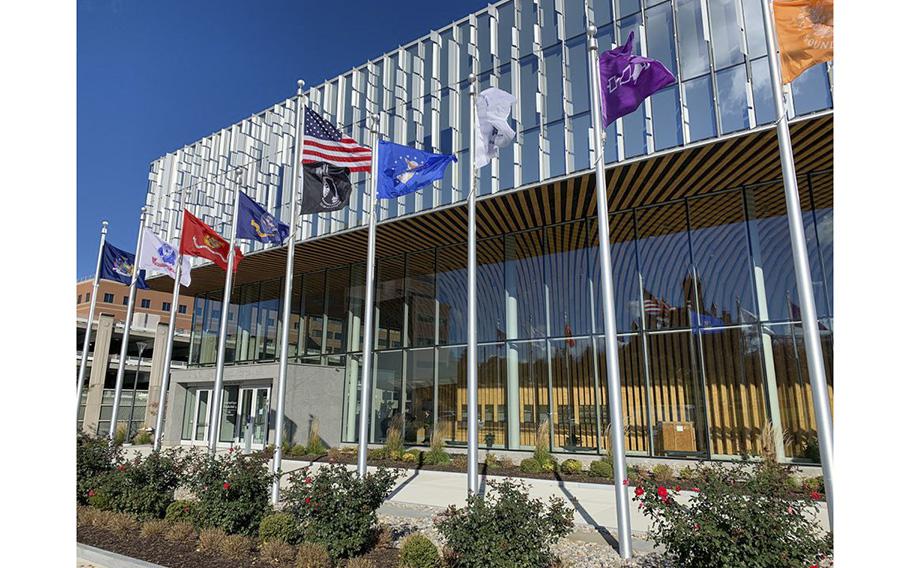
The new National Veterans Resource Center at Syracuse University. (Charlie Miller | cmiller@syracuse.com)
Washington (Tribune News Service) — Senior U.S. military officials will gather in Syracuse next week with about two dozen college presidents to discuss a shared problem between the military and higher education.
Both have struggled to meet recruitment and enrollment goals as the nation emerges from the pandemic and fewer people graduate from high school as a result of demographic changes.
For the military, it’s a critical problem that could endanger the future of the all-volunteer force.
To look for solutions, Syracuse University leaders came up with the idea for a summit on the 50th anniversary of America’s move from a military draft to the all-volunteer Armed Forces.
The two-day event at SU’s National Veterans Resource Center will explore ways that colleges and the federal government can work together to give veterans and military-connected students better access to higher education.
SU Chancellor Kent Syverud told syracuse.com | The Post-Standard that he views the summit as a chance for colleges and universities to step up and eliminate barriers for military service members and veterans.
“The focus of the summit is to ask what higher education can do for veterans and military in the current situation we’re facing, not what veterans and military can do for higher education,” Syverud said.
“That starts from a premise that higher education, and particularly elite higher education, hasn’t exactly been present and accounted for in serving those who have served in recent decades,” he said.
Veterans have often turned to what Syverud calls “lower-resource institutions” rather than big private schools for their college education.
SU has been one of the exceptions among private schools, with soaring veteran enrollment over the past decade since it established the Institute for Veterans and Military Families in 2011.
Vice Chancellor Mike Haynie said military or service-connected students now make up 6% of SU’s total enrollment of about 22,000, compared to about 1% at similar public and private universities.
On top of that, more than 20,000 students per year now graduate from IVMF programs for veterans and members of the military held worldwide, with many earning degrees in nontraditional settings.
Haynie said the institute has taken its program around the globe, educating 192,000 people at 68 military installations in the United States and eight installations overseas. Some SU programs are even offered on board ships at sea.
Other universities have noticed and visited SU to learn more about its programs for veterans and their families, Syverud said. One of those schools, the University of Tennessee, is co-sponsoring the summit Wednesday and Thursday.
“I think we realize we need to do more at Syracuse, but we can’t carry this alone as an obligation for the country,” Syverud said. “We need other universities to partner.”
Several senior officials at the Department of Defense and Department of Veterans Affairs plan to attend the summit, Haynie said.
Those officials include Ashish S. Vazirani, Deputy Under Secretary of Defense for Personnel and Readiness, and Brynt Parmeter, who was hired this week as the first chief talent officer for the Department of Defense.
Journalist and author Sebastian Junger, who reported on the war in Afghanistan, will deliver a keynote address to the university presidents and military leaders on Wednesday.
Haynie said he hopes that ideas for new education programs targeting veterans and military families emerge from the summit.
SU has a history of encouraging veteran and military enrollment, dating back to World War I and the establishment of the Reserve Officer Training Corps (ROTC) programs. The military pays tuition for ROTC students while they go to college and train to become officers.
In 1944, former SU Chancellor William Tolley helped draft the G.I. Bill, which continues to provide tuition assistance for service members, veterans and their dependents.
Syverud said the need for university and military leaders to come up with new ideas is as urgent now as it has ever been.
In three years from 2019 through 2021, 579 colleges and universities closed or merged, according to the U.S. Department of Education.
This year, Cazenovia College announced it was closing its Central New York campus after nearly 200 years. The college blamed financial losses brought on by a 40 percent enrollment drop.
The U.S. military faces similar headwinds. The Army said it missed its fiscal 2022 recruitment goal by 25%, falling 15,000 soldiers short of its needs.
Syverud said the numbers are a sobering reminder of what’s at stake.
“It is an enrollment cliff that we’re facing, including in New York,” he said. “It’s one thing when that causes Cazenovia College to close. That’s a tragedy locally. But if it results in the Army not having soldiers, that’s a national security disaster for the whole country.”
©2023 Advance Local Media LLC.
Visit syracuse.com.
Distributed by Tribune Content Agency, LLC.